Artículos SCI
2011
2011
Materiales Nanoestructurados y Microestructura
Surface-modified Pd and Au nanoparticles for anti-wear applications
J.C. Sánchez-López, M.D. Abad, L. Kolodziejczyk, E. Guerrero and A. FernándezTribology International, 44 (2011) 720-726
Show abstract ▽
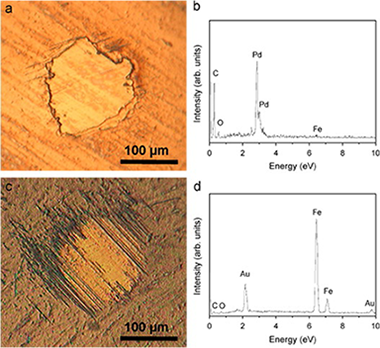
This work reports the employment of metallic nanoparticles (palladium and gold) with a mean particle size of 2.2 nm surface-protected with tetraalkylammonium and alkanethiolate chains, respectively, as lubricant additives. Dispersions of both types of nanoparticles (5 wt%) are prepared using tetrabutylammonium acetate (TBA) and paraffin as base oils, respectively. The tribological properties are then evaluated by a ball-on-disc tribometer at two different loads (7 and 15 N) with excellent results: friction (<0.1), wear rate (not, vert, similar10−10 mm3/Nm). The excellent anti-wear response is explained by the formation of a metal-containing transfer film and their action as counterface spacers avoiding direct contact.
Junio, 2011 | DOI: 10.1016/j.triboint.2009.12.013
Materiales de Diseño para la Energía y Medioambiente
Microstructural and mechanical evaluation of a Cu-based active braze alloy to join silicon nitride ceramics
Singh, M; Asthana, R; Varela, FM; Martinez-Fernandez, JJournal of the European Ceramic Society, 31 (2011) 1309-1316
Show abstract ▽
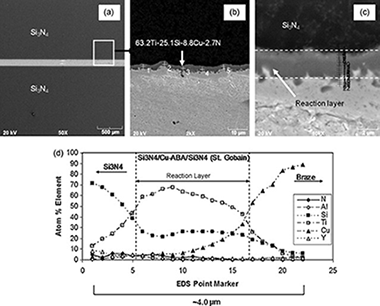
Self-joining of St. Gobain Si3N4 (NT-154) using a ductile Cu–Al–Si–Ti active braze (Cu-ABA) was demonstrated. A reaction zone (∼2.5–3.5 μm thick) developed at the interface after 30 min brazing at 1317 K. The interface was enriched in Ti and Si. The room temperature compressive shear strengths of Si3N4/Si3N4 and Inconel/Inconel joints (the latter created to access baseline data for use with the proposed Si3N4/Inconel joints) were 140 ± 49 MPa and 207 ± 12 MPa, respectively. High-temperature shear tests were performed at 1023 K and 1073 K, and the strength of the Si3N4/Si3N4 and Inconel/Inconel joints were determined. The joints were metallurgically well-bonded for temperatures above 2/3 of the braze solidus. Scanning and transmission electron microscopy studies revealed a fine grain microstructure in the reaction layer, and large grains in the inner part of the joint with interfaces being crack-free. The observed formation of Ti5Si3 and AlN at the joint interface during brazing is discussed.
Junio, 2011 | DOI: 10.1016/j.jeurceramsoc.2010.07.022
Materiales y Procesos Catalíticos de Interés Ambiental y Energético
Photocatalytic coatings of silver–TiO2 nanocomposites on foamed waste-glass prepared by sonochemical process
Lee, S.W., Obregón-Alfaro, S., Rodríguez-González, V.Journal of Photochemistry and Photobiology A: Chemistry, 221 (2011) 71-76
Show abstract ▽
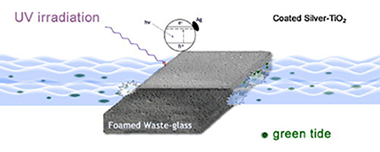
Silver-TiO2 nanocomposite was prepared by photodeposition of silver nanoparticles on the surface of titanium dioxide. The sonochemical method was used for the deposition of silver-TiO2 powder on commercial foamed waste-glass strips (FWGS). The silver-TiO2 and the coated FWGS was characterized by XRD, DRS, SEM, TEM and nitrogen adsorption. In order to enhance silver-TiO2 deposition, different parameters were evaluated such as the solvent effect and use of stabilizing agents. The best deposition was obtained with an aqueous solution of polyvinyl alcohol (PVA) and an ultrasound irradiation source of 23.3 kHz. The photocatalytic activity of the silver-TiO2 coated FWGS was evaluated in the UV photo-assisted destruction of the noxious microalgae, Tetraselmis suecica. It was found that after the photocatalytic irradiation, for 180 min, the algae cells were deformed, fragmented and annihilated, thereby avoiding its regeneration.2
Junio, 2011 | DOI: 10.1016/j.jphotochem.2011.04.026
Materiales de Diseño para la Energía y Medioambiente
Microstructural and mechanical evaluation of porous biomorphic silicon carbide for high temperature filtering applications
Bautista, MA; Cancapa, JQ; Fernandez, JM; Rodriguez, MA; Singh, MJournal of the European Ceramic Society, 31 (2011) 1325-1332
Show abstract ▽
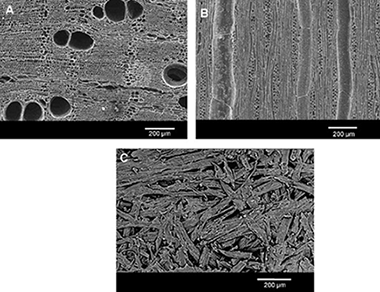
Biomorphic SiC (bioSiC) is a low cost SiC/Si composite obtained by melt infiltration of carbon preforms obtained from the pyrolysis of cellulose precursors. The porosity and pore size distribution of bioSiC can be tailored for specific applications by adequate selection of the wood precursor. Natural and artificial industrial woods were explored as possible bioSiC precursors. Silicon was removed by chemical etching. Relevant microstructural parameters such as pore size distribution, total porosity, and permeability were characterized. Since the filtration process involves large pressure gradients along the material at high temperatures, mechanical properties of porous bioSiC from the different precursors were evaluated at room temperature and 800 °C. The feasibility of porous bioSiC as a filtration material for high temperature gasification processes is discussed in terms of these properties. MDF-bioSiC is shown to be a promising material for such applications because of its good mechanical properties, interconnected porosity, pore sizes, and permeability.
Junio, 2011 | DOI: 10.1016/j.jeurceramsoc.2010.06.014
Reactividad de Sólidos
Thermal study of unaltered and altered dolomitic rock samples from ancient monuments - The case of Villarcayo de Merindad de Castilla la Vieja (Burgos, Spain)
Perez-Rodriguez, JL; Duran, A; Perez-Maqueda, LAJournal of Thermal Analysis and Calorimetry, 104 (2011) 467-474
Show abstract ▽
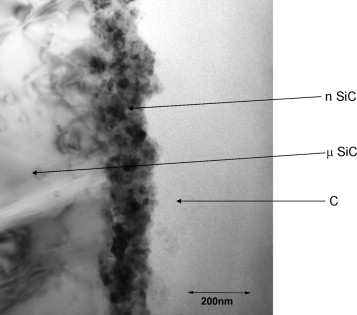
In this study, the decomposition behaviour of unaltered and altered dolomitic rock samples used in Cultural Heritage buildings was studied by simultaneous TG-DTA experiments at different atmospheres, X-ray diffraction in a high-temperature chamber, and evolved gas analysis. The components of dolomite rock samples and hydrated calcium oxalate formed during the alteration processes of the rocks were characterized, and the decomposition mechanisms of these components were determined. The TG-DTA experiments carried out at CO2 atmosphere were used to determine the carbonate compounds in the rock samples. The TG-DTA study characterized the presence of organic compounds formed during the biological degradation of the rock samples, possibly responsible of the hydrated calcium oxalate formation.
Junio, 2011 | DOI: 10.1007/s10973-011-1348-5
- ‹ anterior
- 353 of 422
- siguiente ›














